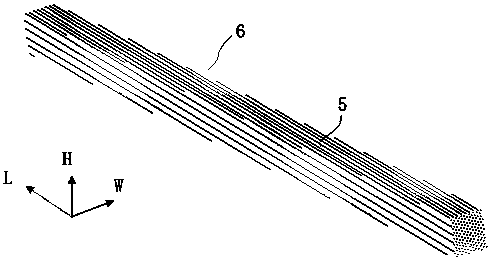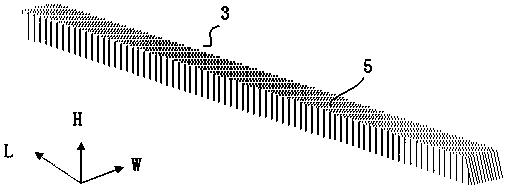A high-strength non-delamination template and its preparation method
A high-strength, delaminated technology, applied in the field of continuous fiber reinforced building formwork and building formwork, can solve the problems of few cycles, poor weather resistance, complex processing, etc., to reduce the cost of single use, reduce forest damage, reduce The effect of resource depletion rate
- Summary
- Abstract
- Description
- Claims
- Application Information
AI Technical Summary
Problems solved by technology
Method used
Image
Examples
preparation example Construction
[0028] A preparation method of a high-strength non-delamination template, the steps of which are:
[0029] (1) Preparation of the board core: making wooden materials into cuboid-shaped slats, the slats are divided into slat a6 and slat b3, the length direction of the slat a6 is consistent with the growth direction of the wood, and the height direction of the slat b3 is Consistent with the growth direction of the wood, the lath a6 and the lath b3 are respectively formed by a cuboid wooden strip, or the lath a6 and the lath b3 are respectively spliced along the length direction of the lath by a plurality of wooden strips through the adhesive in the way of miter joint or butt joint Formed, the butt angle is θ=90°, and the miter angle is θ<90°, so as to meet the length and size requirements of the core 1; along the width direction of the slats: Adhesives are used to bond between adjacent slats in the form of butt joints. One piece, the butt joint angle is θ=90°, so as to meet th...
Embodiment 1
[0034] In this embodiment, along the direction of the long and wide surface 5 formed by the length and width of the vertical slats, the height of the core 1 is 10 mm, wherein the width of the slats a6 and slats b3 is 2 mm, and the width of the slats b3 is 2 mm. The ratio of the number of slats to the number of slats a6 is 2. The slats a6 and slats b3 are respectively formed by splicing a plurality of wooden slats through the adhesive phenolic resin along the length direction of the slats. The butt joint angle is θ=90°. In the strip width direction, the corresponding same planes of adjacent slats are bonded as a whole by means of butt joint with adhesive phenolic resin. The total weight of the fiber composite reinforced surface layer, the weight percentage of the continuous fiber is 20wt%, and the surface density of the continuous fiber reinforced composite surface layer 2 is 300g / m 2 , which consists of a layer of continuous fiber-reinforced prepreg and a non-woven fabric cove...
Embodiment 2
[0036] In this embodiment, the ratio of the number of slats b3 to the number of slats a6 is 0.75, and the rest of the content is the same as in Example 1. After mechanical performance testing: the longitudinal static bending strength is 37 MPa, and the longitudinal elastic modulus is 2800 MPa , the static bending strength in the transverse direction is 22 MPa, and the elastic modulus in the transverse direction is 3100 MPa; the water resistance type I peeling performance test: no change; the vertical drop test from a height of 6 meters: no cracks.
PUM
| Property | Measurement | Unit |
|---|---|---|
| height | aaaaa | aaaaa |
| width | aaaaa | aaaaa |
| width | aaaaa | aaaaa |
Abstract
Description
Claims
Application Information
 Login to View More
Login to View More - R&D
- Intellectual Property
- Life Sciences
- Materials
- Tech Scout
- Unparalleled Data Quality
- Higher Quality Content
- 60% Fewer Hallucinations
Browse by: Latest US Patents, China's latest patents, Technical Efficacy Thesaurus, Application Domain, Technology Topic, Popular Technical Reports.
© 2025 PatSnap. All rights reserved.Legal|Privacy policy|Modern Slavery Act Transparency Statement|Sitemap|About US| Contact US: help@patsnap.com



